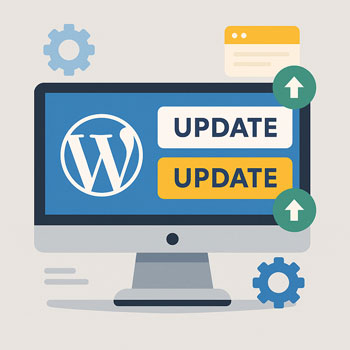
Updating WordPress, Themes, and Plugins Safely
Regular updates keep your website secure, fast, and compatible with new features. However, updating without preparation can cause errors, broken layouts, and plugin conflicts. Follow this safe workflow to protect your site.
1) Before You Update
- Create a fresh backup of your database +
wp-contentfolder.
- Create a fresh backup of your database +
- Check PHP version compatibility (Hosting → Tools).
- Check plugin/theme changelogs for known issues.
- Verify staging site exists or create one if available.
- Disable cache temporarily (plugin or hosting cache).
Tip: Update on a weekday morning (your host’s support staff is available and traffic is low).
2) Update Order (Safest Order)
- Step 1: Plugins → update one at a time.
- Step 2: Themes → update parent theme first, then child theme if needed.
- Step 3: WordPress Core → apply major or minor updates.
This order reduces the risk of breaking site functionality caused by plugin/theme incompatibilities with new WordPress versions.
3) Updating Plugins Safely
- Update one plugin at a time, not all at once.
- Refresh your site and check key pages (Home, About, Services, Contact).
- Check console errors (Developer Tools → Console) if something looks off.
- If using Elementor, update Elementor before add-ons.
- Avoid unreliable or unmaintained plugins (last updated > 1 year).
Tip: Major plugin updates (e.g., WooCommerce, Elementor, WPML) should be tested on staging first.
4) Updating Themes
- Check if your theme has a required companion plugin (Astra, Kadence, GeneratePress).
- Update the parent theme first.
- Child theme changes will remain safe unless you edited parent theme files directly.
- After update, review header/footer, global styles, and layouts for styling shifts.
Warning: Never edit your main theme’s files directly. Always use a child theme or custom plugin for code snippets.
5) Updating WordPress Core
- Minor updates (security & maintenance): safe to apply immediately.
- Major updates (feature changes, UI changes): test first if using many plugins or advanced builders.
- After update, regenerate assets (some themes/builders require this).
- Clear caches: plugin, hosting, CDN, and browser.
Critical: After major updates, test forms, logins, checkout, and menus for expected behavior.
6) Using a Staging Site
- Create staging inside your host (most have 1-click staging).
- Apply updates on staging first.
- Test key pages, forms, sliders, pop-ups, and checkout (if any).
- Push changes to live only after confirming everything looks correct.
Staging protects live visitors from issues and lets you spot conflicts early.
7) After Updating
- Clear all caches (plugin, CDN, hosting).
- Check the frontend logged in and logged out.
- Test forms, navigation, animations, pop-ups, and contact buttons.
- Check site speed (sometimes updates re-enable unused scripts).
- Look in Tools → Site Health for new warnings.
If something breaks: roll back using your backup or plugin rollback (WP Rollback or built-in version restore).
8) Plugin & Theme Auto-Updates (Use Carefully)
- Enable auto-updates only for trusted, essential, lightweight plugins.
- Avoid auto-updating visual builders, WooCommerce, multilingual plugins, and security plugins.
- Review auto-updates weekly in the WordPress dashboard.
- Always maintain a reliable daily backup schedule.
9) Final Update Safety Checklist
- Backup completed before update.
- Cache disabled or cleared.
- Plugins updated one at a time.
- Themes updated (parent first).
- WordPress core updated safely.
- Frontend tested thoroughly.
- No errors in Site Health.
- Full cache regenerated after updates.
